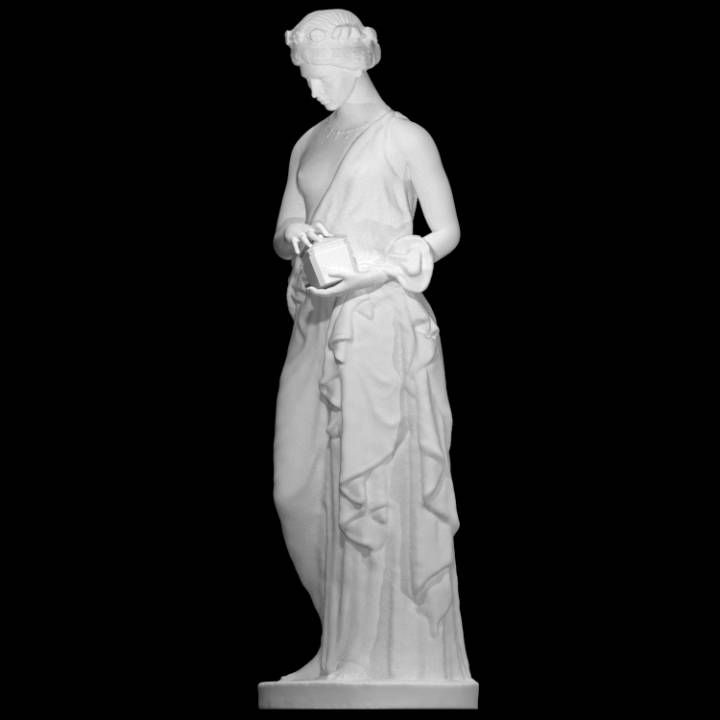
Pandora
myminifactory
John Gibson was a renowned artist born in Wales who initially trained in Liverpool before relocating to Rome in 1817. He spent most of his life there, deeply influenced by the Neo-classical sculpture of Antonio Canova and Bertel Thorwaldsen, both prominent artists based in Rome at the time. Despite his connection with Roman art, Gibson continued to showcase his work at the Royal Academy in London, where he was elected a Royal Academician in 1838. The Pandora statue exemplifies Gibson's mastery of Neo-classical style. Its classical subject matter, posture, and attire, as well as the smooth marble surface, are all characteristic of Gibson's work and reflect his debt to Canova and Thorwaldsen. In this sculpture, Pandora is portrayed on the verge of opening a box that, according to Greek mythology, released all the sorrows of the world. Her expression conveys a sense of foreboding at what she is about to do. Gibson created multiple versions of this sculpture; one example, signed 'IOANNES GIBSON ME FECIT ROMAE,' is housed in the Museum and was given by Mrs. Penn. This must be the version previously owned by Mr. Penn, as mentioned in Lady Eastlake's biography of Gibson written in 1870. Another version can be found at the Lady Lever Art Gallery in Port Sunlight. Pandora, according to Greek mythology, was the first woman created by Hephaestus and Athena on Zeus' instructions. Each deity endowed her with a unique quality. Pandora was designed to bring misfortune to men. In Hesiod's Works and Days, it is recounted that Zeus sent Pandora to Epimethus, who fell under her charm and made her his wife. She opened the lid of a great pot (Pandora's box), releasing all the ills in the world. Hope alone remained inside. In Christian thought, she was seen as the pagan counterpart of Eve. In Greek mythology, Pandora was the first woman to inhabit the earth. Jupiter instructed her not to open a box he had given her, but she disobeyed and released all evils and miseries contained within upon humanity. This marble sculpture was crafted by John Gibson (1790-1866), who spent most of his professional life in Rome and admired Canova's work. The Pandora myth first appears in lines 560–612 of Hesiod's epic poem, Theogony (circa 8th–7th centuries BC). At the time, humans had received fire from Prometheus, an angry Zeus decided to give humanity a punishing gift as compensation. He ordered Hephaestus to create the first woman, a "beautiful evil" whose descendants would torment the human race. Athena dressed Pandora in a silvery gown, embroidered veil, garlands, and a silver crown. When she appeared before gods and mortals, wonder seized them. However, she was "sheer guile, not to be withstood by men." Hesiod elaborated on her nature: From her is the race of women and female kind; from her is the deadly race and tribe of women who live amongst mortal men to their great trouble, no helpmates in hateful poverty but only in wealth. Hesiod lamented that men trying to avoid evil by avoiding marriage would fare no better. He reaches deadly old age without anyone to tend his years, and though he has a sufficient livelihood while alive, when dead, his kinsfolk divide his possessions amongst them. Hesiod concedes that occasionally a man finds a good wife but still "evil contends with good." This object is part of the Scan The World initiative, a non-profit project created by MyMiniFactory to digitally archive fully 3D printable sculptures and artworks from across the globe for public access free of charge. Scan The World is an open-source community effort; if you have interesting items around you and would like to contribute, email stw@myminifactory.com to find out how you can help. Courtesy of the Victoria and Albert Museum, London.
With this file you will be able to print Pandora with your 3D printer. Click on the button and save the file on your computer to work, edit or customize your design. You can also find more 3D designs for printers on Pandora.
